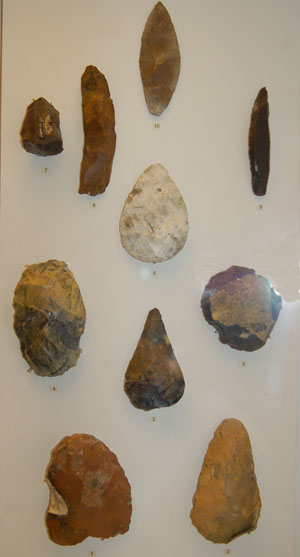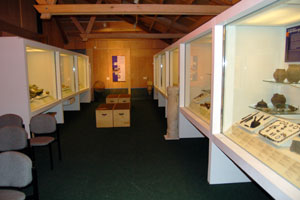
Upon first entering the Visitor Centre this panel, entitled Discover the story of West Stow, is showing a video of the original dig, with Stanley West's tools, and the official report on the site. |

The visitor quickly notices that a wide range of accurate replica items and informative books are available for sale, as well as educational toys for younger visitors. |

There is also a range of information boards within the Visitor Centre. This panel illustrates woodworking as part of the reconstructions. In order to go further and see the exhibits and reconstructed village, at this stage it is necessary to buy a ticket. |

Visitors may go straight out to view the anglo-saxon village, but if they wish to see what was happening in the area before the arrival of the saxons, they will start with the Archaeology gallery. The first case on the left contains the fossilised bones of a Plesiosaur.
195-150 million ybp ("ybp" means "years before present", or "years ago")
Lower Jurassic period, from Rosswell pits, Ely. |

Next come fossils from the Ice Ages.
Numbered clockwise from bottom left
1 Elephant pelvis, Fornham all Saints, 175,000ybp
2&3 Mammoth tusk and tooth, between 1.6million ybp and 10,000 ybp
4 Woolly Rhino tooth, 350,000 ybp to 10,000 ybp
5 Hippo heelbone from Hawkedon, 200,000 ybp
6 (centre) Paleolithic Hand Axe from Keswick, Norfolk |

These paleolithic tools date from before 35,000 ybp (1-6), and between 35,000 BC and 10,000 ybp (7-10)
Numbered from the bottom left, then horizontally
1 Found at Keswick in Norfolk, 2 from Blaxhall, 3 from West Stow, 4 from Icklingham, 5 from Barnham and 6 from Haverhill.
7 & 8 are from Beck Row, 9 from Lakenheath, and 10 (top) from Bury St Edmunds. |

These mesolithic blade flints are typically small, and get as much cutting edge as possible from the flint core. Sometimes smaller pieces were combined in a wooden handle to give a composite tool.
So-called tranchet arrowheads had the a cutting edge instead of a point. Tranchet axe heads similarly had the cutting edge along the longest sides.
Nearly all from West Suffolk |

Neolithic tools were far more varied than in the mesolithic era. The high status polished stone axehead below was made of stone from the Lake District, but found at Woolpit. The polished axe above was from Kentford. These items may have been intended for show rather than for use.
The carved axehead with a spiral pattern is from Garboldisham, and was made of polished Red Deer antler.
All from West Suffolk or Norfolk |

More Neolithic tools. Flint survives in the ground, but we must not forget that most tools would be made either exclusively, or in part, from wood, supplemented by leather bindings, plant fibres and natural glues of various types. Nothing usually remains of the organic tools or weapons in use.
Antler picks do survive and these two come from Grimes Graves and Feltwell.
All from West Suffolk or Norfolk |

These barbed and tanged flint arrowheads come from what has been called the Beaker Period. This runs from ca. 2800 – 1900 BC, and is the term for a widely scattered cultural phenomenon of prehistoric western Europe starting in the late Neolithic running into the early Bronze Age. Beakers arrived in Britain around 2500BC, declined in use around 2200-2100BC with the emergence of food vessels and cinerary urns and finally fell out of use around 1700BC (Needham 1996).
These arrowheads were found at Bury St Edmunds, Icklingham, Lakenheath, Mildenhall, West Row and West Stow. |

The heavy stone tools are made of stone imported into Suffolk. The shaft holes were bored out with bow drills. The antler adzes are beaker period from Burnt Fen. The adze of epidiorite is from Mildenhall. Three axe hammers are of quartz dolerite from the Whin Sill in Northumberland, but found in Denham, Icklingham and Mildenhall. The last axe head is made of ophitic gabbro found in Hockwold from the beaker period. |


